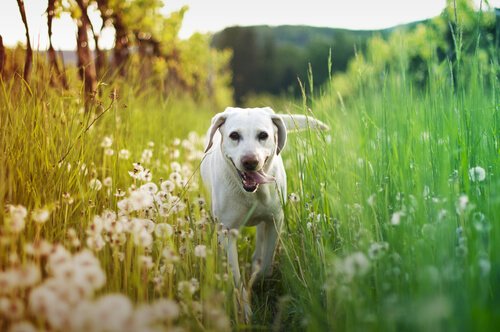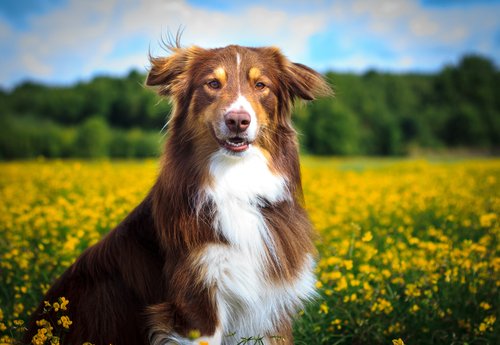Poisonous Plants for Dogs

Our pets are exposed to dangers that humans are unaware of. Some are more obvious, like pesticides, rat poison, or drugs. However, you can make sure that your pet remains far away from them, but sometimes these dangers go unnoticed. For example, poisonous plants.
There are many plants that can irritate or poison dogs. Therefore, it’s important to recognize them, know their symptoms in pets, and know what to do in case of poisoning.
Train your pet to avoid poisonous plants

When you first learn about poisonous plants, you may immediately start thinking of getting rid of all the plants in your home. However, this would only be a temporary solution because your pet could eat them on the street or at a friend’s houses. Therefore, the solution is to train your pet not to approach plants without your approval.
Teach your dog that he cannot get close or touch what’s near him by just saying no. It’s possible he may resist, or maybe he’s still puppy, which usually have a hard time at obeying commands. In that case, you can spray a bitter non-toxic product on the plant. However, no matter how much you try to train your dog, there still are factors that can get him to eat plants. For example:
- High temperatures and lack of water. If it’s a hot day and there is no water around or your dog’s water is warm, he might start chewing on plants with soft stems to quench his thirst. Make sure he always has clean fresh water to drink.
- Boredom. When a dog is home alone for a long period of time, he needs to do something to entertain him. He usually does this by chewing on everything, including plants.
- Moving. If you moved to a new home, the animal will want to investigate everything, including the plants.
- Lack of space at home. When a dog doesn’t have enough space for himself, it’s normal for a canine to become aggressive and destructive, he may resort to chewing up everything around him. Make sure the animal has enough space to move around and he feels that he has his own space at home.
What poisonous plants can I find?
You can find a wide variety of poisonous plants for your dog. Here are some examples:
- Holly
- Oleander
- Amaryllis
- Caladium
- Cyclamen
- Clivia miniata
- Monstera deliciosa
- Croton
- Dumb cane
- Peace lily
- Poinsettia
- Ivy
- Hydrangea
- Morning glory
- Hyacinth
- Iris
- Marijuana
- Mistletoe
- Daffodil
- Tulip
These are only some poisonous plants for pets, but there could be even more. Ask your veterinarian and tell him/her to give you a list of the most common ones in your community.
What do I do if my dog is poisoned?

Poisoning isn’t always that obvious, since the symptoms could appear in digestive, nerve, or hematological problems. The first thing you can do is check what plants are at home. This way it will be much faster to know what poisoned your dog in order to treat him.
Immediately take him to the veterinarian once you notice something is wrong. However, it’s not always easy to diagnose and prescribe medicine in poisoning cases, since it’s difficult to know how much was ingested. However, poisoning is usually resolved with simple and routine treatments. So if you act quickly, there is nothing to worry about.
Our pets are exposed to dangers that humans are unaware of. Some are more obvious, like pesticides, rat poison, or drugs. However, you can make sure that your pet remains far away from them, but sometimes these dangers go unnoticed. For example, poisonous plants.
There are many plants that can irritate or poison dogs. Therefore, it’s important to recognize them, know their symptoms in pets, and know what to do in case of poisoning.
Train your pet to avoid poisonous plants

When you first learn about poisonous plants, you may immediately start thinking of getting rid of all the plants in your home. However, this would only be a temporary solution because your pet could eat them on the street or at a friend’s houses. Therefore, the solution is to train your pet not to approach plants without your approval.
Teach your dog that he cannot get close or touch what’s near him by just saying no. It’s possible he may resist, or maybe he’s still puppy, which usually have a hard time at obeying commands. In that case, you can spray a bitter non-toxic product on the plant. However, no matter how much you try to train your dog, there still are factors that can get him to eat plants. For example:
- High temperatures and lack of water. If it’s a hot day and there is no water around or your dog’s water is warm, he might start chewing on plants with soft stems to quench his thirst. Make sure he always has clean fresh water to drink.
- Boredom. When a dog is home alone for a long period of time, he needs to do something to entertain him. He usually does this by chewing on everything, including plants.
- Moving. If you moved to a new home, the animal will want to investigate everything, including the plants.
- Lack of space at home. When a dog doesn’t have enough space for himself, it’s normal for a canine to become aggressive and destructive, he may resort to chewing up everything around him. Make sure the animal has enough space to move around and he feels that he has his own space at home.
What poisonous plants can I find?
You can find a wide variety of poisonous plants for your dog. Here are some examples:
- Holly
- Oleander
- Amaryllis
- Caladium
- Cyclamen
- Clivia miniata
- Monstera deliciosa
- Croton
- Dumb cane
- Peace lily
- Poinsettia
- Ivy
- Hydrangea
- Morning glory
- Hyacinth
- Iris
- Marijuana
- Mistletoe
- Daffodil
- Tulip
These are only some poisonous plants for pets, but there could be even more. Ask your veterinarian and tell him/her to give you a list of the most common ones in your community.
What do I do if my dog is poisoned?

Poisoning isn’t always that obvious, since the symptoms could appear in digestive, nerve, or hematological problems. The first thing you can do is check what plants are at home. This way it will be much faster to know what poisoned your dog in order to treat him.
Immediately take him to the veterinarian once you notice something is wrong. However, it’s not always easy to diagnose and prescribe medicine in poisoning cases, since it’s difficult to know how much was ingested. However, poisoning is usually resolved with simple and routine treatments. So if you act quickly, there is nothing to worry about.
This text is provided for informational purposes only and does not replace consultation with a professional. If in doubt, consult your specialist.








